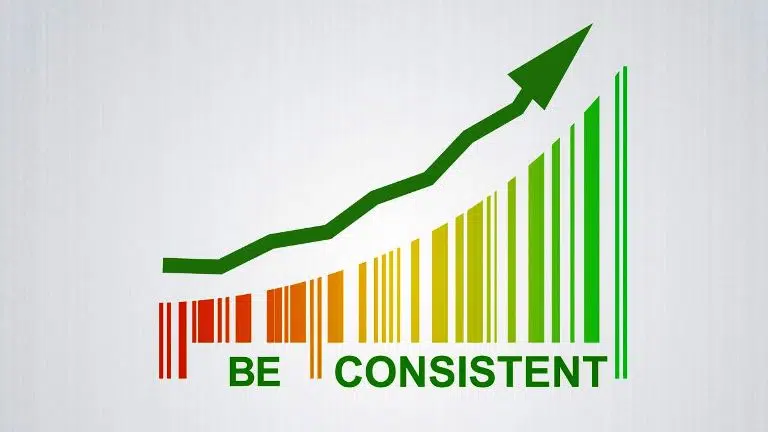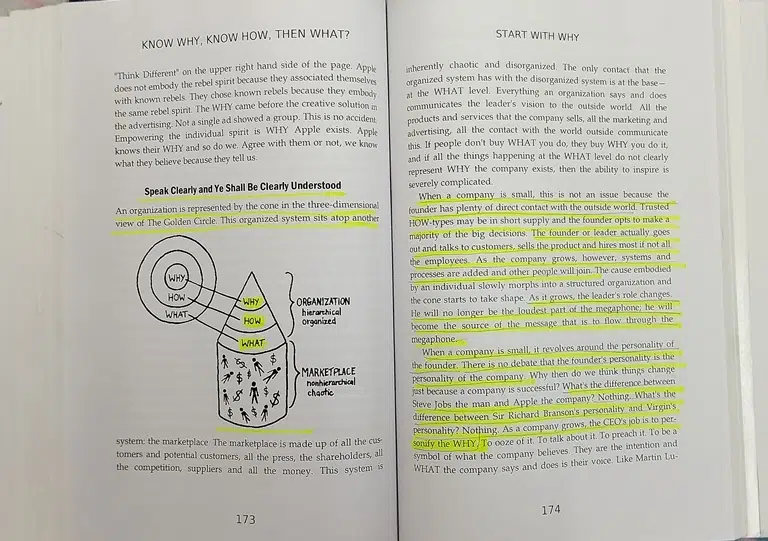In today’s competitive world, businesses want to be noticed and gain market share.
But why do some companies succeed in winning hearts, retaining loyal customers, and inspiring innovation while others struggle?
Simon Sinek’s groundbreaking book, “Start with Why” dissects this puzzle, revealing the missing ingredient that lies at the root of great leadership and sustainable success.
This summary explains the ‘Golden Circle’, an important idea that will change your thoughts about business, leadership, and goals.
His main IDEA:
Focus on why you’re doing something that makes you more likely to succeed.

- Part 1: A World That Doesn’t Start With Why
- Chapter 1: Assume You Know
- Chapter 2: Carrot And Sticks
- Part 2 An Alternative Perspective
- Chapter 3: The Golden Circle
- Chapter 4: This Is Not Opinion, This Is Biology
- Chapter 5: Clarity, Discipline, And Consistency
- Part Three: Leaders Need The Following
- Chapter 6: The Emergency Of Trust
- Chapter 7: How a Tipping Point Tips
- Chapter 8: Start With Why But Know How
- Chapter 9: Know Why, Know How, Then What?
- Chapter 10: Communication Is Not About Speaking, It’s About Listening
- Part 5: The Biggest Challenge Is Success
- Chapter 11: When Why Goes Fuzzy
- Chapter 12: Split Happens
- Part 6: Discover Why
- Chapter 13: The Origin Of A Why
- Chapter 14: The New Competition
Part 1: A World That Doesn’t Start With Why
Chapter 1: Assume You Know
There is a wonderful story about a group of American car executives who visited Japan to see a Japanese assembly line. The doors were put on the hinges at the end of the line, the same as in America. But something was missing.
In the United States, a worker would use a rubber mallet to tap the edges of the door to make it fit perfectly. But in Japan, that job didn’t seem to exist.
Confused, the American auto executives asked how the Japanese ensured the door fit perfectly. Their Japanese guide looked at them and smiled sheepishly.
"We make sure it fits when we design it."
In the Japanese auto plant, they didn’t examine the problem and accumulate data to figure out the best solution—they engineered the outcome they wanted from the beginning.
If they didn’t achieve their desired outcome, they understood it was because of a decision they made at the start of the process.
Chapter 2: Carrot And Sticks
There are only two ways to influence human behavior: manipulation and inspiration.
Manipulating the sticks or inspiring the carrots is used as a metaphor.
Manipulation is a common tactic used in sales and marketing. It includes things like dropping the price, running a promotion, using fear, peer pressure, or aspirational messages. Companies that don’t know why their customers are their customers often rely on manipulation to get what they want.
When people are inspired, they are more likely to be loyal customers and employees. They are also more likely to spread the word about your company to others.
Companies that understand their purpose, cause, or belief will likely be more successful. Once they know their why, they can communicate it to their customers and employees in an authentic and inspiring way.

Part 2 An Alternative Perspective
Chapter 3: The Golden Circle
Very few leaders choose to motivate people by inspiring them instead of manipulating them. The writer explains The Golden Circle in three parts: Why, How, and What.
The term starts from the outside of the circle and moves inward.
- What: Every company on the planet is aware of what they do. It’s true no matter how big or small a company or industry they’re in. Everyone can easily describe the products or services their company sells or the job function within the company.
- How: Some people and companies know how they do what they do? Whether you call them a ‘’differentiating value proposition’’ or a ‘’unique selling proposition,’’ HOWs are often given to explain how something is different or better.
- Why: Can hardly any people or companies figure out why they do what they do? This isn’t about running a profitable company—that’s a result. Why is it all about your purpose? Why does your company exist? Why do you get out of bed in the morning? And why should anyone care?
Knowing your Why is not the only way to be successful, but the only way to maintain lasting success and have a greater blend of innovation.
Manipulation rather than inspiration quickly becomes the strategy of choice to motivate behavior.

Chapter 4: This Is Not Opinion, This Is Biology
In this chapter, we begin by examining human nature’s desire to belong. We feel good when those around us share our values and beliefs. When we feel like we belong, it makes us feel safe and connected.
To know More About human nature, read Robert Greene’s 48 Laws
The principles of the Golden Circle are much more than a communications hierarchy. The power of Why is not opinion; it is biology. The newest area of the brain, our Homo Sapien Brain, Is the Neocortex.
Neocortex: It corresponds with the WHAT level. The neocortex is responsible for logical and analytical thought and language.
Limbic Brain: The limbic brain is powerful enough to drive behavior that sometimes contradicts our rational and analytical understanding of a situation.
People don’t buy WHAT you do: They buy WHY you do. A failure of communication WHY creates nothing but stress or doubt. The heart represents the limbic, feeling part of the brain. And the brain is where we learn and understand things rationally. Most companies are good at convincing people to buy their products or services.
Chapter 5: Clarity, Discipline, And Consistency
The fifth chapter explains why the Golden Circle is important, but only when it’s done right.
Everything you say and do needs to show what you believe. A WHY is just a belief. HOW are the actions you take to realize that belief? And WHAT are the results of that action. With consistency, people will see and hear what we believe.
After you understand why, follow your values, and do what you say and do, the last thing you need to do is ensure everything is in order.
If you don’t know why you want a house (your purpose), all the decisions about how to build it or what it should look like get confusing.
- Maybe you build a fancy house when what you really need is a cozy one.
- Maybe you try to do everything yourself to save money, but forget that some things need experts.
Knowing your WHY helps you make smart choices about the HOW and WHAT.
This applies to more than houses!
- Companies: A company that knows its WHY (like making people’s lives better) makes clearer choices about products (the WHAT) and strategies (the HOW)
Whether in leadership, decision-making, or communication, starting with WHY has a profound and long-lasting impact on the result; starting with WHY is what inspires people to act.

Part Three: Leaders Need The Following
Chapter 6: The Emergency Of Trust
In the year 1980, a report revealed that Continental Airlines was the worst airline in the industry. When Simon visited this airline in 1994, he found drastic changes. Gordon Bethune wrote a book called “From Worst to First” that tells the story of how Continental changed.
The company is responsible for looking after the employees, as happy employees ensure happy customers. And happy customers ensure Happy shareholders. Bethune shared this illogical belief. Trust is not a checklist. Taking care of all your responsibilities does not create trust. Trust is a feeling, not a fact.
When things go wrong, we trust some people and companies, while we don’t trust others when everything seems to be going well. “ You should not tell a lie to your doctor, like you can’t lie to your employee.” Bethune set out to change the culture by giving everyone something they could believe in.
What specifically did he tell them to believe that the worst airline in the industry could become the best with the same people and the same equipment?
He didn’t focus on specific changes to how they did things. Instead, he asked them to believe:
- Employees matter: He showed them he trusted and valued them, ending the fear and mistrust that was hurting the company.
- Customers deserve respect: He emphasized the importance of ensuring that things are done correctly for customers, such as being punctual.
- We can be the best: He inspired them to see that even though they’d messed up in the past, they could work together to build a great airline.
It was about changing the attitude and believing they COULD do better, even with the same resources.

Chapter 7: How a Tipping Point Tips
This chapter explains the Law of Diffusion and Innovation. Everett M. Rogers wrote this book in 1962, focusing on product acceptance’s ‘bell curve’.
Understanding How Ideas Spread
- The Law of Diffusion of Innovations: Describes how new ideas or products spread throughout a society. People fall into categories: innovators(2.5%), early adopters(13.5%), early majority(34%), late majority(34%), and laggards(16%).
- Innovators and Early Adopters: These groups are crucial. They love new ideas and technology, being willing to try things even if they aren’t perfect. They have an impact on society.
- The Tipping Point: To reach the mass market (the majority), you must first win over the innovators and early adopters. They create the social buzz that convinces the majority to consider your product or idea.
Why This Matters for Change
If you want to change an industry or society, you can’t just focus on the logical reasons why your idea is good. You need to:
- Target the Right People: Find the innovators and early adopters who resonate with the core message of your idea, as they’ll be your champions to the rest of the world.
- Focus on the ‘Why’: Why does your idea matter? This feeling is more important to people who are starting out than what it looks like or how much it costs.
- Let the Majority Follow: Once you’ve built momentum with early adopters, word-of-mouth and social proof will lead your idea to broader acceptance.

Chapter 8: Start With Why But Know How
- Energy: Excites and motivates in the short term. It’s visible and easy to notice and replicate. Think of someone like Steve Ballmer, with his energetic presence.
- Charisma: Inspires long-term commitment. It’s more hidden, driven by a deep belief in a larger purpose. Bill Gates illustrates this – his focus on solving problems and bringing opportunity is what inspires people.
Key Points
- Great leaders possess charisma because they have a clear sense of purpose (their “why”).
- Gates’ belief in computers was transformative not just because of the technology itself, but because of its potential to make people more productive and realize their potential.
- Charisma is more than just feeling good for a short time. It makes you feel inspired and loyal for a long time.
Chapter 9: Know Why, Know How, Then What?
The Golden Circle has a three-dimensional view that represents an organization. This organized system sits on top of another system, the marketplace. The marketplace comprises all the clients and potential clients, the media, the shareholders, the competitors, the suppliers, and the money.
This is not an issue when a company is small because the founder has plenty of direct contact with the outside world. The leader goes out and talks to customers, sells the product, and hires most, if not all, employees. As the company grows, processes and more people join.
As it grows, the leadership role changes. He/she will no longer be connected to the outer world. He will become the source of the message that is to flow through the common crowd. When the company is small, it revolves around the founder’s personality. There is no debate that the founder’s personality is the company’s personality.
What’s the difference between Steve Job, the Man, and Apple, the company?
While Steve Jobs’ personality and ideas deeply shaped Apple, especially in its early years, the company is much larger than him and can continue to innovate even without him.

Chapter 10: Communication Is Not About Speaking, It’s About Listening
Ronald Reagan, the great communicator, was aware of the power of symbols. In 1982, he was the first president to invite a hero to sit on the balcony of the House Chamber during the State of the Union Address. This tradition has continued every year since then.
A man who was full of optimism, knew the value of symbolizing the value of America Instead of just talking about it. The words are hollow, but deeds and value are deep.
Most companies have logos, but few have been able to turn them into meaningful symbols. Because most companies are bad at communicating what they believe. So, it will follow that most logos are deprived of any meaning. People must be inspired to use a logo to describe who they are.
There are more profound examples: Harley-Davidson. In truth, most people who tattoo Harley-Davidson logos on their bodies have no idea what Harley’s stock price is. Symbols are any realistic representation of a clear set of values and beliefs.
Part 5: The Biggest Challenge Is Success
Chapter 11: When Why Goes Fuzzy
Do you think companies should care about more than making money? Why or why not?
Sam Walton started Wal-Mart with a simple idea: offer everyday things at low prices. With hard work and always thinking about winning, he turned one store into a giant company! But Walmart wasn’t just about being cheap.
Walton believed in helping people – his employees, his customers, and his community. He thought they’d take care of him if he cared for them. This made Wal-Mart successful and loved.
Sadly, after Walton died, things changed. Walmart forgot why it existed – that helping people was more important than being the cheapest. They got into trouble for treating employees and customers unfairly. It seems like they traded in a good reason for doing business (the WHY) for just making money (the HOW).
Chapter 12: Split Happens
Do you think some companies really DO care about more than just money?
Businesses start as ideas. Even massive companies like Microsoft and Walmart were small once! People started them with a passion for something essential. That passion fueled them in the beginning. But along the way, many companies grow bigger and focus only on things they can measure, like money. Then, they forget their WHY – the reason they started in the first place.
For Walmart, their WHY was helping people. For Microsoft, it was changing the world through technology. When companies become obsessed with growing what they do and forget the passion of why they do it, things go bad. Employees and customers can feel it. Occasionally, the company must rediscover It’s WHY or hire a leader who lives that original dream.
Part 6: Discover Why
Chapter 13: The Origin Of A Why
Do you think big companies constantly try to control people, or can they be good occasionally? Why?
In the 1960s, two people named Steve Wozniak and Steve Jobs wanted to fight big companies. Steve Jobs and Steve Wozniak wanted everyone to have the power to change things! So, they made Apple – a company meant to help the little guy take on the giants. It wasn’t just about cool tech for them.
Jobs and Wozniak made life easier by inventing one of the first user-friendly home computers. Then, things like the iPod and iTunes shook up the old-fashioned music industry. The iPhone blew past those clunky cell phones.
Apple isn’t for everyone, but for those who love it, it’s more than just stuff. It’s about being yourself, dreaming big, and not being afraid to challenge the rules.

Chapter 14: The New Competition
In a world obsessed with beating rivals, truly inspiring companies aren’t focused on who they’re up against. Instead, they compete against themselves. They have a strong WHY – their reason for existing – and everything they do aims to improve and stay true to that purpose.
This makes them unique and innovative, and they attract loyal followers who believe in what they stand for. Traditional competition becomes less important because what they offer is unique. Instead of chasing trends or matching competitor moves, they push themselves to get better every day.
Example: Think of a sports team. Some rivals hate each other and constantly try to beat the other. But the best teams focus on getting stronger, playing their game, and becoming champions on their terms. They might still watch what opponents do, but mainly to learn, not copy.
